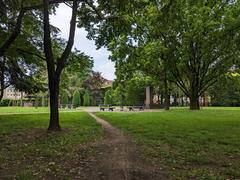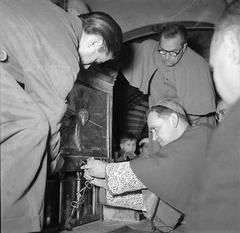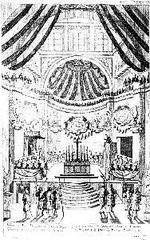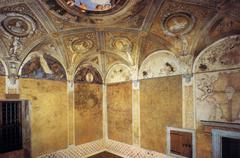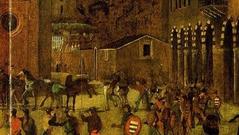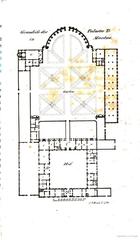The Studiolo of Isabella d’Este in Mantua, Italy: Visiting Hours, Tickets, and Historical Significance
Date: 04/07/2025
Introduction
Located within the magnificent Ducal Palace (Palazzo Ducale) in Mantua, Italy, the Studiolo of Isabella d’Este stands as a remarkable symbol of Renaissance artistry, humanist ideals, and pioneering female patronage. Once the private refuge of Isabella d’Este (1474–1539), Marchioness of Mantua, this chamber invites visitors to experience the intellectual and cultural vibrancy of early 16th-century Italy. Curated by Isabella herself, the studiolo showcases a blend of exquisite wood intarsia, allegorical paintings, and rare artifacts—offering a window into the mind of one of the Italian Renaissance’s most influential women. Today, the Studiolo is a must-visit for art aficionados, history enthusiasts, and travelers eager to explore Mantua’s rich heritage (Encyclopedia Britannica; Palazzo Ducale Mantova; National Gallery; Wikipedia).
This comprehensive guide details the Studiolo’s historical context, significance, visitor information, and practical travel tips to ensure an enriching cultural journey in Mantua.
Table of Contents
- Introduction
- Historical Background and Significance
- Visiting the Studiolo of Isabella d’Este: Practical Information
- Visual Media and Virtual Experiences
- Frequently Asked Questions (FAQ)
- Additional Mantua Highlights
- Practical Travel Tips
- References
Historical Background and Significance
Origins and Patronage
The Studiolo was conceived for Isabella d’Este, Marchioness of Mantua, a leading patron of the Italian Renaissance (Encyclopedia Britannica). Born into the Este family of Ferrara and married to Francesco II Gonzaga, Isabella brought a passion for the arts, literature, and music to Mantua. The Studiolo emerged as her personal retreat—a space dedicated to reflection, intellectual exchange, and the display of prized collections.
Architectural Setting and Design
Originally located in the Castello di San Giorgio and later relocated to the Corte Vecchia of the Ducal Palace, the Studiolo is a compact, refined chamber adjacent to Isabella’s audience hall, the Grotta (Palazzo Ducale Mantova; Wikipedia). The room is renowned for its masterful wood intarsia (marquetry) panels, marble portals, and a painted ceiling simulating a starry sky. Trompe-l’oeil illusions depict shelves filled with books, musical instruments, and scientific tools, visually expressing Isabella’s cultivated environment.
Artistic Program and Commissioned Works
Between 1497 and 1519, Isabella commissioned some of the era’s greatest painters to create mythological and allegorical works for her studiolo. These included:
- Andrea Mantegna, “Parnassus” (1497): A celebration of poetic inspiration.
- Perugino, “Combat of Love and Chastity” (1503): The triumph of virtue over passion.
- Lorenzo Costa, “Allegory of Isabella d’Este’s Coronation” (c. 1505–06): Honoring Isabella’s virtues.
- Correggio, “Allegory of Virtue” (c. 1525–1530): Symbolizing the victory of virtue.
Many original paintings are now housed in museums worldwide, yet the Studiolo retains reproductions and digital displays that evoke the original ambiance (National Gallery; Getty Research Journal).
Cultural and Intellectual Importance
The Studiolo was more than a private study—it was a statement of Renaissance humanism and female agency. Its collections reflected Isabella’s intellectual pursuits and her connection with scholars and artists, reinforcing her standing in the Gonzaga court and beyond. The space became a model for similar chambers and cabinets of curiosities throughout Europe (Getty Research Journal; The Burlington Magazine).
Later History and Preservation
Following Isabella’s death, many artworks were dispersed—particularly during the 17th-century sales to Charles I of England (Royal Collection Trust). Nevertheless, the Studiolo’s architectural features and decorative scheme have been preserved and partially restored within the Ducal Palace, allowing visitors to experience the spirit of the original space (Palazzo Ducale Mantova).
Legacy and Influence
The Studiolo of Isabella d’Este helped define the tradition of Renaissance studioli and cabinets of curiosities, merging art, scholarship, and self-fashioning. Isabella’s example as a female patron continues to inspire studies of gender and cultural history (The Burlington Magazine).
Visiting the Studiolo of Isabella d’Este: Practical Information
Visiting Hours
The Studiolo, as part of the Ducal Palace, is typically open Tuesday to Sunday from around 8:15 am to 7:15 pm (last entry at 6:15 pm). The palace is closed on Mondays and certain public holidays. Hours may vary seasonally or during special events, so always consult the official website before your visit.
Tickets and Booking
- Standard Admission: Approximately €15 for adults, with reduced rates for students, seniors, and children.
- Free Entry: Often available on the first Sunday of each month, though this may attract larger crowds.
- Guided Tours: Highly recommended and available in several languages, focusing on the Studiolo, art collections, and palace history. Advance booking is advised, especially during peak seasons or special exhibitions.
Tickets cover access to the entire palace, including the Studiolo, Camera degli Sposi, and gardens.
Accessibility
The Studiolo is located on the ground floor and is generally accessible to visitors with limited mobility. Some areas of the palace may present challenges due to historic architecture; contacting the palace in advance is recommended to discuss specific needs.
Getting There and Nearby Attractions
The Ducal Palace is in Mantua’s historic center, adjacent to Piazza Sordello. It is a 15-minute walk from the main train station and easily accessible on foot. Nearby sites include the Camera degli Sposi, Palazzo Te, Basilica di Sant’Andrea, and vibrant city squares like Piazza delle Erbe.
Visual Media and Virtual Experiences
- On-Site: The Studiolo features period furnishings, wood marquetry panels, and reproductions of the original paintings. Non-flash photography is generally allowed.
- Virtual Tours: Cutting-edge 3D reconstructions and online archives provide immersive digital access to the Studiolo and its masterpieces (Isabella d’Este Virtual Studiolo; IDEA: Isabella d’Este Archive; Virtual Reconstruction Project).
Frequently Asked Questions (FAQ)
Q: What are the Studiolo’s visiting hours?
A: Open Tuesday–Sunday, generally from 8:15 am to 7:15 pm; closed Mondays. Check updates on the official website.
Q: How much are tickets?
A: Standard admission is around €15, with reductions for students and seniors; free entry is available on select days.
Q: Is the Studiolo wheelchair accessible?
A: The Studiolo is on the ground floor and accessible, but some palace areas may not be. Contact in advance for assistance.
Q: Are guided tours available?
A: Yes, bookable online or via local agencies, and are highly recommended.
Q: Can I take photographs?
A: Non-flash photography is allowed; tripods and selfie sticks are not.
Additional Mantua Highlights
Palazzo Te
A masterpiece of Mannerist architecture by Giulio Romano, Palazzo Te is celebrated for the Sala dei Giganti’s dramatic frescoes and tranquil gardens. Combined tickets with Palazzo Ducale are available (Things.in).
Piazza Sordello & Piazza delle Erbe
Mantua’s historic squares are framed by medieval palaces, the cathedral, and vibrant market scenes (Travel Connect Experience).
Basilica di Sant’Andrea
Designed by Alberti, this basilica is a pilgrimage site housing relics and features works by Correggio and Mantegna. Open daily with free entry (Things.in).
Parco del Mincio and Lakes
Mantua’s lakes and Parco del Mincio are ideal for walks, cycling, and boat tours, offering scenic views of the city’s skyline (Culture Activities).
Teatro Bibiena
A historic theater renowned for its ornate interiors and excellent acoustics, offering guided tours and performances (The Italy Edit).
Practical Travel Tips
- Getting There: Mantua is connected by train to major Italian cities and is about 30 km from Verona airport.
- Best Time to Visit: Spring and autumn are ideal; summers can be hot and humid.
- Getting Around: The city is walkable; bike rentals and boat tours are available.
- Local Cuisine: Don’t miss tortelli di zucca, risotto alla pilota, and sbrisolona cake in local trattorias (Travel Connect Experience).
- Photography: Top spots include the Camera degli Sposi, Sala dei Giganti, and lakeside promenades.
- Accessibility: Many sites are accessible, but check in advance for specifics.
References and Further Reading
- Isabella d’Este, Encyclopedia Britannica
- Studiolo di Isabella d’Este, Palazzo Ducale Mantova
- Andrea Mantegna: The Triumphs of Caesar, National Gallery
- Studiolo di Isabella d’Este, Wikipedia
- Studiolo and Cabinets of Curiosities, Getty Research Journal
- Isabella d’Este and the Renaissance Studiolo, The Burlington Magazine
- Isabella d’Este Virtual Studiolo
- IDEA: Isabella d’Este Archive
- Royal Collection Trust: Mantua Pictures
- Things to do in Mantua, Things.in
- Culture Activities
- Travel Connect Experience
- The Italy Edit
Conclusion
The Studiolo of Isabella d’Este remains one of Mantua’s most treasured Renaissance sites—an intimate chamber where art, intellect, and power converge. Despite the dispersal of its original masterpieces, the studiolo’s preserved space within the Palazzo Ducale continues to evoke the humanist spirit and refined taste that Isabella championed. Visitors benefit from thoughtfully organized tours, practical visitor services, and innovative digital resources illuminating the studiolo’s rich symbolism. Complement your visit with explorations of Mantua’s other historical highlights, such as the Camera degli Sposi, Palazzo Te, and Basilica di Sant’Andrea, for a comprehensive immersion in this exceptional city.
To make the most of your experience, consider leveraging guided tours, the Audiala app for audio guides, and checking current opening hours and ticketing information on official channels. Stay connected via social media for news about special events and exhibitions. The Studiolo stands as a lasting symbol of Renaissance brilliance and Isabella d’Este’s enduring legacy within Mantua’s cultural heritage.

